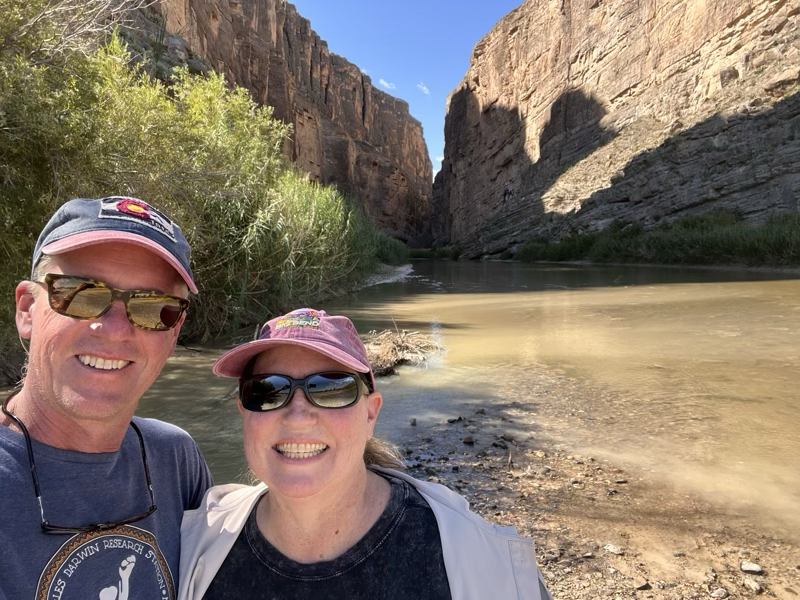Category: article
You are viewing all posts from this category, beginning with the most recent.
Exploring Custer - Day 3
The morning dawned crisp and clear, it was great to sleep with the windows open taking in the cool clean air. I made my coffee, and thanks to our range extender I was even able to read the news and extend my 73 day streak on Wordle. I had just finished wordle when I heard Brian lighting the campfire outside. The plan for the day was to start with a hearty breakfast and then head out to do the Cathedral Spires and Little Devils Tower hike. After hiking we will do the black hills loop drive, including Iron Mountain highway and the Needles highway.
We began with an egg bake cooked over an open fire. Delicious and the hashed browns on the bottom of the pan were wonderfully crispy.
The Cathedral Spires hike was wonderful, but Little Devils Tower was spectacular! The Cathedral Spires were the inspiration for Mount Rushmore. The hike up there was fine but when you finally get into the spires themselves you can see how inspirational they really are.
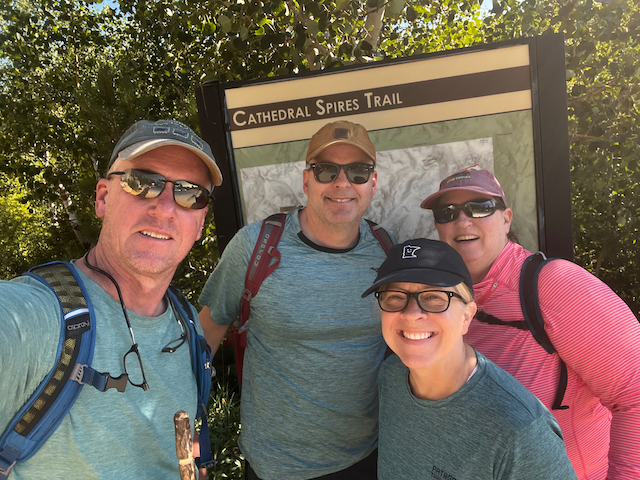
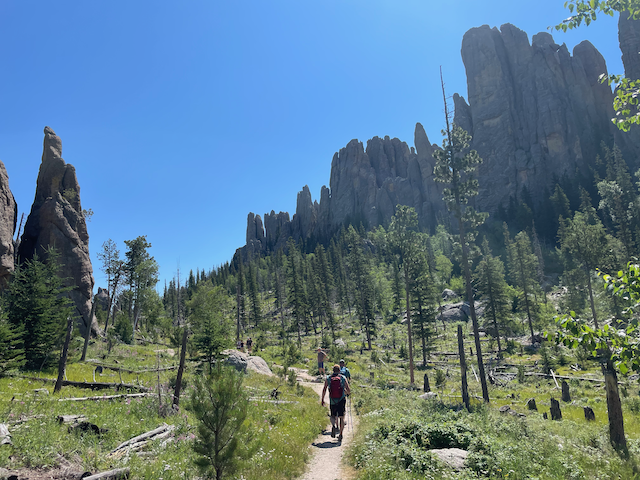
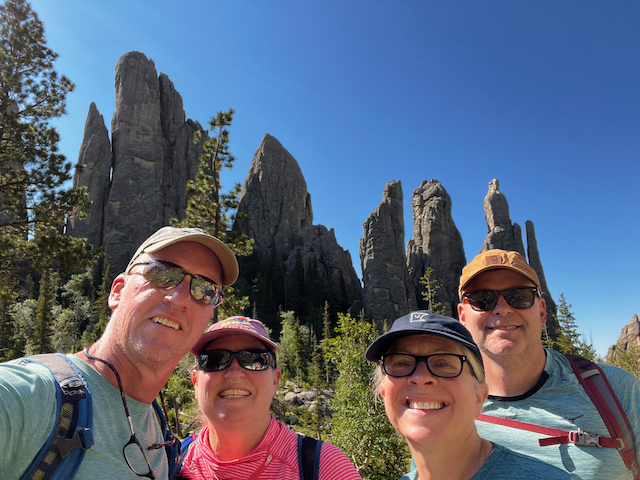
We arrived at a clearing with a nice shady area to sit, but there were also trails leading off in a couple of different directions. Brian and I were convinced there must be more so we explored a bit only to realize that there was not much more to see. When we got back Jane and Holly pointed to the sign below.
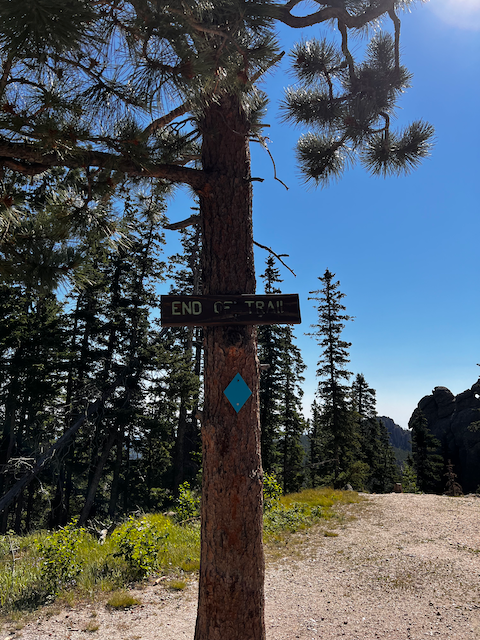
OK, so we were undisputedly at the end of the trail.
Just a short distance back down the trail was the turn off to head to Little Devils Tower. This was largely a climb and we were not sure where it was going to end, spoiler alert its up on top of these rocks.
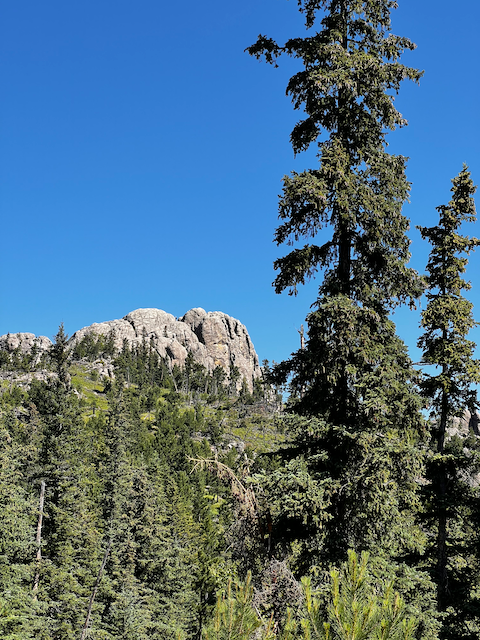
The trail was full of little chips of Mica and in some places it was so fine that the very fine sand looked muddy! We also walked through a whole section of trail full of “fools gold.” Both Holly and Jane were sporting knee braces so we were trying to take care, and in fact one elderly lady we met on the trail referred to them as “brave”. We laughed about that for a long time. Unfortunately when we got about a quarter mile from the payoff to this part of the hike it was clear that those with knee braces were not going to go rock climbing on all fours.
That left Brian and I to make our way to the summit on our own. It was definitely a good bit of rock scrabbling. But the view from the top was well worth the effort. Just imagine standing on top of that little dome of rock. Nothing to block your view for 360 degrees.
Here is Brian making his way up one of the easier parts of the final push.

And here is the best I can do from the top. Pictures do not even come close to capturing what we saw.
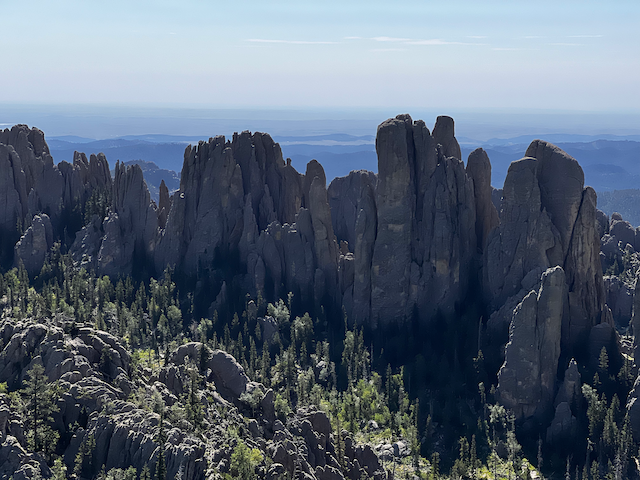
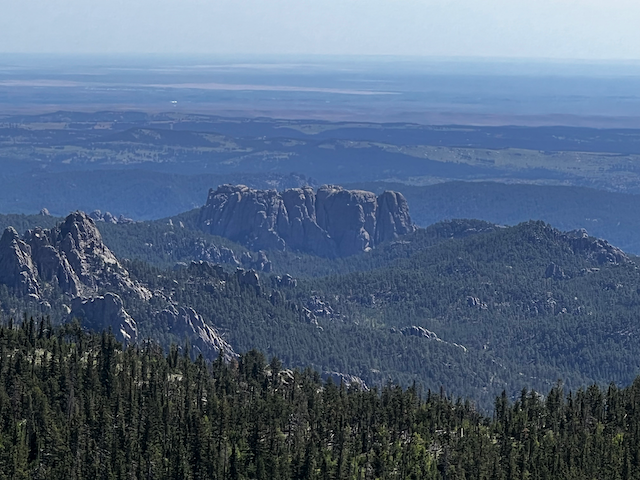
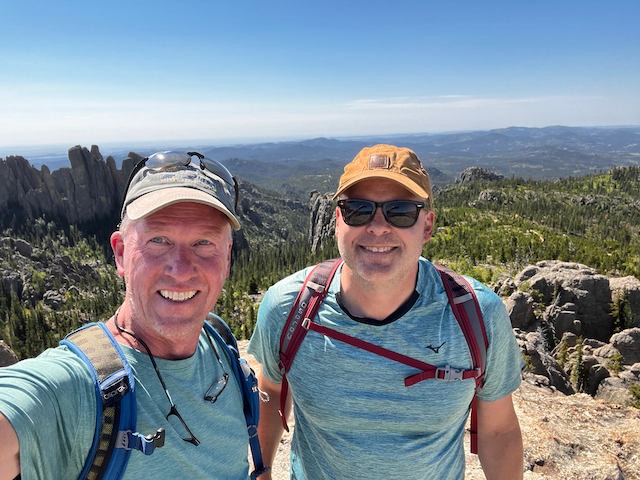
On the way down we had one very funny moment when Brian’s water bottle slipped out of his back pack and went clattering down the granite. We thought for sure the women would hear it and think one of us had fallen down the hill. Just a little bit of extra character for the bottle.
The rest of the day we were in the car, enjoying the Needles Highway. There are three tunnels carved through the granite, but they are only 8 feet 9 inches wide and just over 10 feet tall. This is why we had to take the long way around to our campground! No way is the camper going to fit through this tunnel!
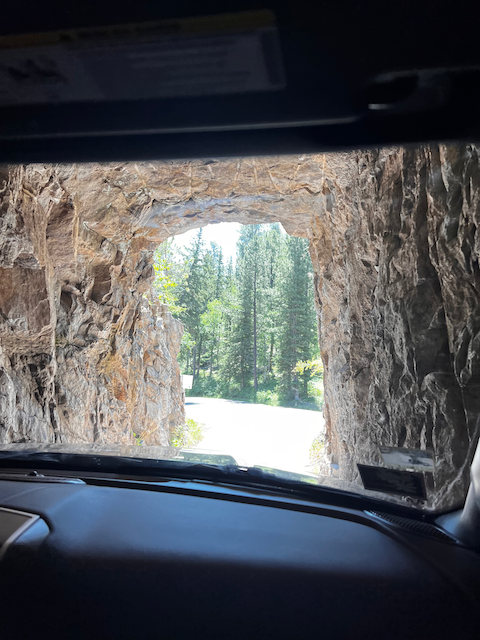
The Iron Mountain highway with its pigtail bridges and views of Mount Rushmore is also a great part of the drive. We didn’t see any bison or other wildlife. But we enjoyed the drive and the views.
At one point near the end we got enough service for some emails to arrive. Luckily I looked long enough to see an urgent email regarding one of our grant proposals that was due in just an hour or so. Apparently our part needed to be submitted. So I tried to log in on my phone and navigate the NSF website to submit our grant. Now the NSF site is a big pile of crap from the 90’s that is hard to navigate on the best of days with a desktop browser. Trying to navigate it in a half-panic on your phone is horrible. Let’s just say there is nothing responsive about the design and the design did nothing to anticipate the use of mobile devices. In the end I gave up and sent my password to the grant officer at Michigan, who ended up having to call NSF tech support because indeed the submit button was not where it should have been. It turns out that being an administrator and Principle Investigator is not enough to submit a proposal, I needed to have a new role as Authorized Organizational Representative. Of course the site itself does not say that. Dear NSF better error messages would help…
Dinner for the evening was our celebratory anniversary meal. Steak over the fire — someone left the sous vide in California! — baked potatoes, salad and a couple of bottles of really nice wine we brought for the occasion.
Mexican food so good…
Today (Day 2) was a day of driving across South Dakota. What do you see when driving across South Dakota? Billboards, lots and lots of billboards. Wall Drug, of course. But lots of others too, apparently the Firehouse Brewery is trying to be the new Wall Drug. They have signs and bright red fire trucks every few miles. Here are a few of our favorite slogans.
Mexican food so good that Donald Trump would build a wall around it!
I don’t even remember if the name of the restaurant was mentioned. But I would love to eat there to support the owners.
There is wisdom in wine.
There is bacteria in water
Love it, let’s have a glass of wine to celebrate the author of that sign.
I have to say that South Dakota is not a good value; it is pretty expensive scenery at almost $1.00 per mile! The reason that today was particularly expensive was the headwind. We were driving straight into a 20 mph wind gusting to 40 mph at times. Our gas mileage is normally 9-10 mph while pulling our camper, but today we were averaging 5.3. Yikes! I was beginning to think that today was our day for mechanical troubles until we stopped to fill up. I could hardly push the door open against the wind. Although relieved to understand why we were getting such poor mileage, Knutson’s van performed perfectly and with a diesel engine they were only using about a quarter of a tank to our 25 gallon fills.
We made it to the Badlands in the late morning and took the scenic drive through. The last time I was on this road, I was on my bike, so it was a different experience to see it from the truck.

The Badlands are so interesting with millions of years of geologic history on display. They have a map that shows what things looked like all those years ago and clearly this part of the world was under water.
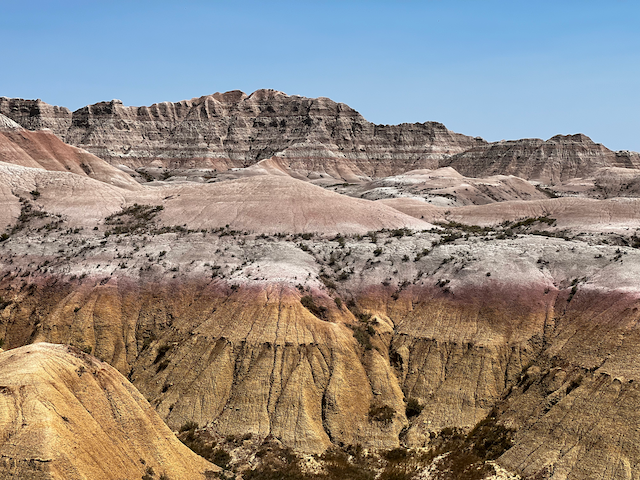
After we got through the Badlands our final 100 miles for the day brought us to Custer State Park. I think it must be one of the most beautiful state parks in the country. Our camp sight was beautiful, if a little small to back into. We set up camp at the Sylvan Lake campground and after a round of beers in the shade we headed out for the short hike around the lake.
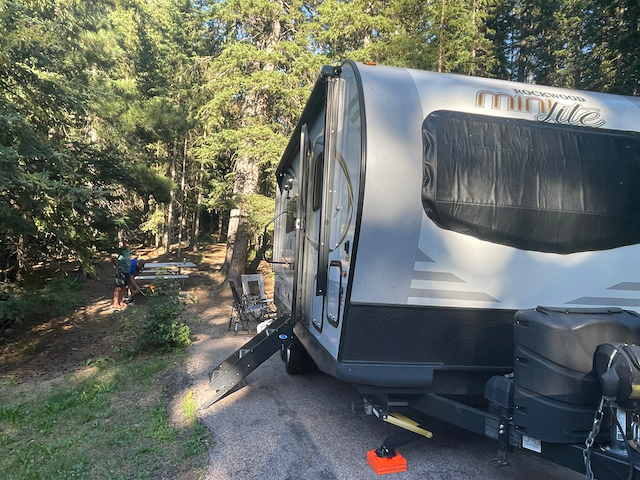

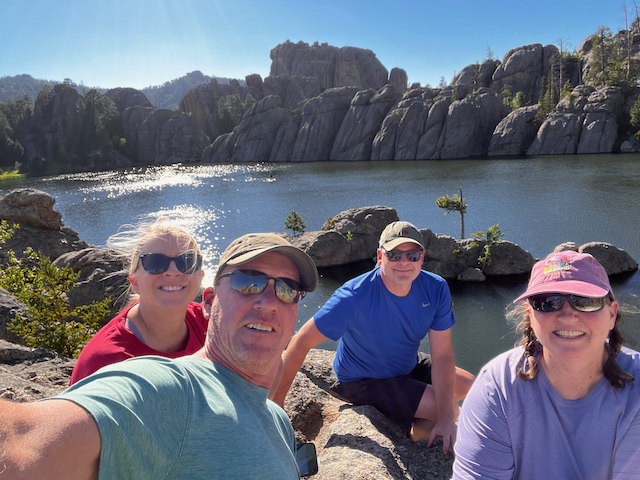
Dinner was wonderful, we had some delicious french dip foil sandwiches. Holly had made them with cheese and roast beef and then wrapped them in foil, we put them over the fire and they came out perfectly. Meanwhile we took on the task of trying to figure out the problem with the gas supply to the grill and griddle. By process of elimination we determined that it was the quick connect coupler on the camper that had to be clogged. The protective cover had either come off or we had forgotten to put it on, so it wasn’t too surprising that road grime was interfering with the flow. We took it off and washed it good with soapy water. That cleared it all up and so we are back in business to cook with gas. However we are having fun improvising our cooking over the open camp fire.
Unsurprisingly holly and Brian had not slept very well their first night in their van, so we called it a night relatively early.
The Adventures Begin
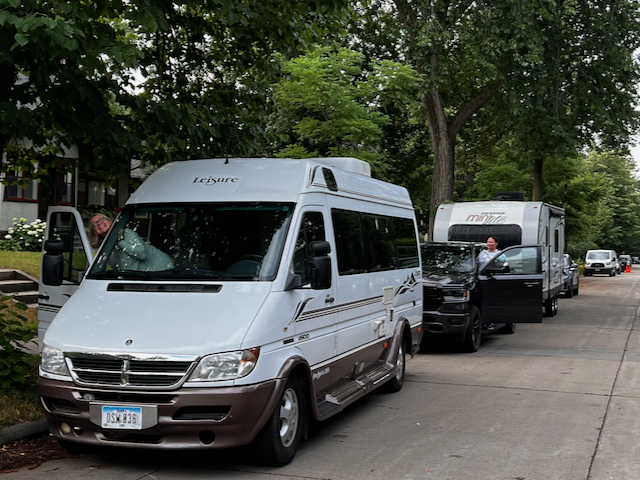
Every five-ish years we have a special trip with our good friends Brian and Holly. We were all married on the same weekend in June, but one year apart. Brian was my college roommate and my best man. So to celebrate our five year anniversaries we do a trip together. We have been to Door County, Hawaii, the Mediterranean, the Caribbean, you get the idea. Every time we go it is an adventure.
This year is our 36th anniversary and their 35th. A few years ago we rented a 32 foot RV and visited Banff and Glacier. This year, we decided to keep the national park theme going and are heading to the Grand Tetons and Yellowstone. Since we have a travel trailer, Brian and Holly decided to rent a camper van and we would drive and camp together.
We were about an hour down the road when we got the following text from Holly.
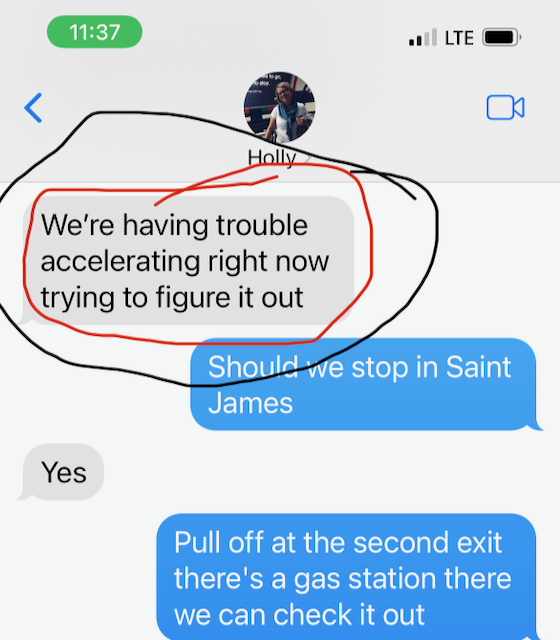
So we pulled off in Saint James and parked behind the Caseys. After turning off the van and restarting the engine everything seemed fine. So we continued on down the road. We got all the way to Heron Lake when it happened again. So we pulled into the Conoco station and they called their rental company. Once again restarting the van fixed the problem. After the third time we decided to pull over in Worthington and get some help from the rental company. The first thing we learned was that the roadside assistance provided with the rental was completely useless. They said they found one place that could help us, in the little town of Lismore, that could get us in on Wednesday! Discussions ensued with the owner of the RV who seemed pretty knowledgeable and correctly diagnosed what the problem was. Meanwhile the rental company got busy trying to locate an alternative RV to bring to us. The RV was in “limp mode”. When the RPMs exceed 2700 the turbo is not able to keep up and goes into a mode where you cannot accelerate.
At the owners suggestion we continued toward Sioux Falls, with a stop for gas in Luverne where gas was just $4.09. While we were in town we made a quick stop at Papik motors where we were able to get the error code read, which confirmed the diagnosis. A little further down the road we got word that we should head to Chris’s Auto Repair in Sioux Falls. If you ever need some work done on your car in Sioux Falls I would highly recommend, they are the nicest group you will find. They did some more diagnostic work to figure out exactly what needed to be replaced. Unfortunately they couldn’t get the part until Wednesday, so the owner dispatched his mechanic to make the four hour drive to Sioux Falls with the part. We now knew that we were not going camp in the badlands, so we found a couple of sites at the very nice Lake Vermillion recreation area.
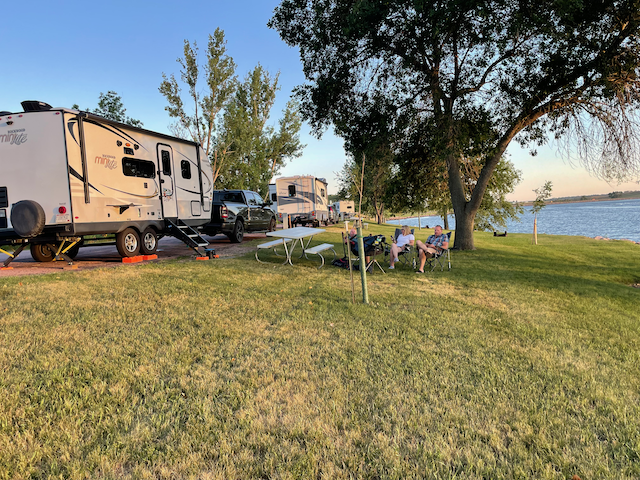
While waiting for the mechanic, we had happy hour and made some burgers. We were planning on grilling, but for some reason could not get the grill to light! Another mystery to figure out when we get settled in Custer. The induction burner and frying pan worked out just fine, so we had our burgers and enjoyed the views of the lake.
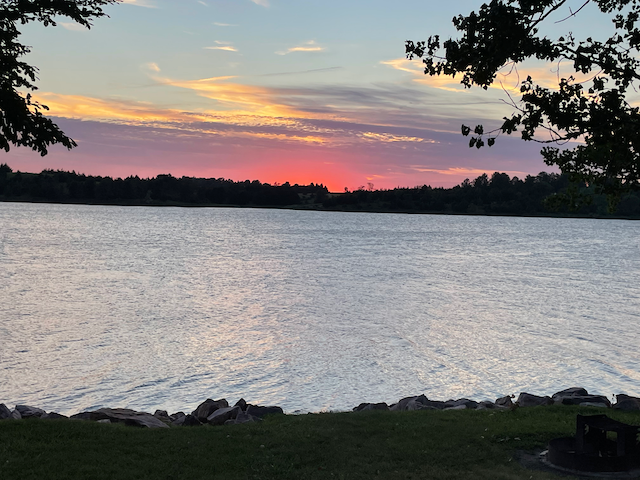
At around 9:00 the mechanic arrived, well it was actually not the mechanic but someone’s teenage son. Whatever! He got the job done and the RV has been running like a champ all day today.
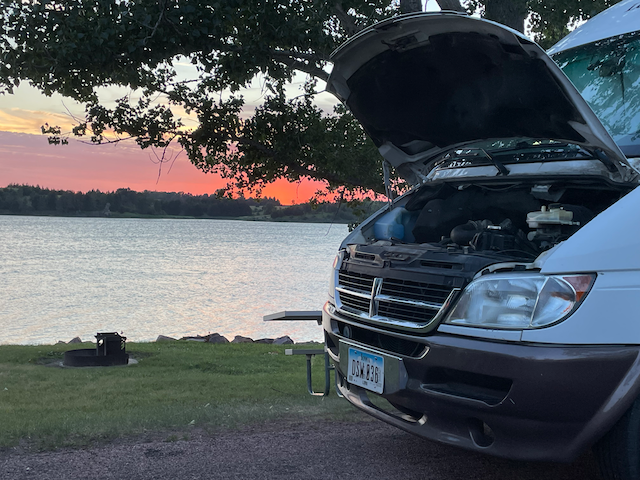
Hiking the Wire Pass Canyon
Unfortunately our lottery attempts were a bust and neither of us got selected. So we did the next best thing and hiked Wire Pass. Getting to Wire Pass is about half the adventure as it is 7.9 miles off the highway on a very bumpy dirt and gravel road. Jane loves driving the truck in these off-road conditions, I just grit my teeth until we are there.
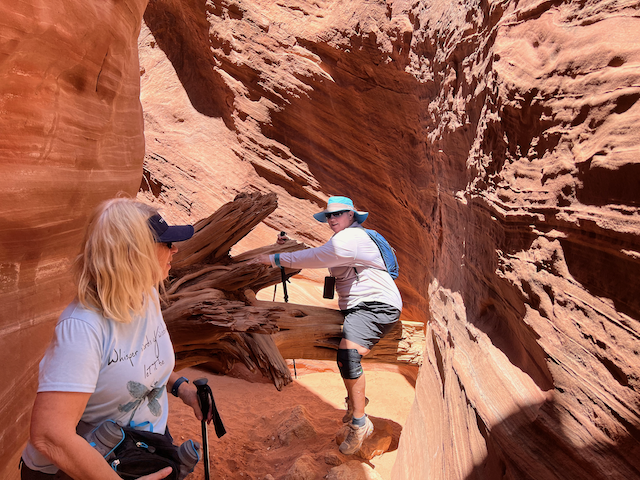
It turns out that the trailhead for Wire Canyon is also the trailhead for the Wave (also known as North Coyote Canyon.) We thought about just following the trail to the wave, but decided that if there were rangers checking passes that it probably was not worth it.

In the end Wire Canyon was great, lots of slot canyons to walk through and just a huge wall at the end. Not only the wall, but there are ancient Petroglyphs carved into the wall.
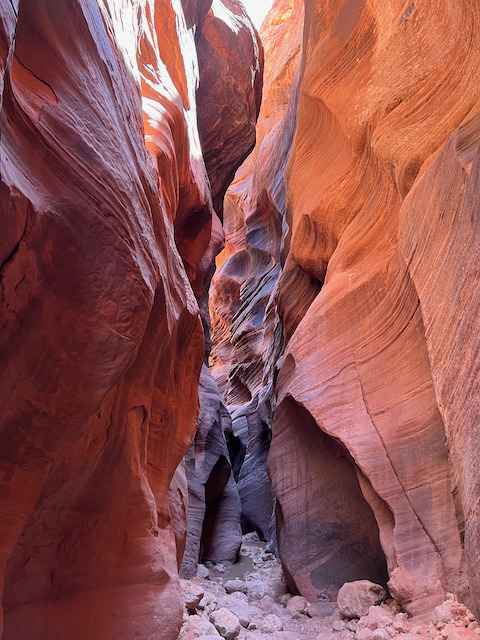
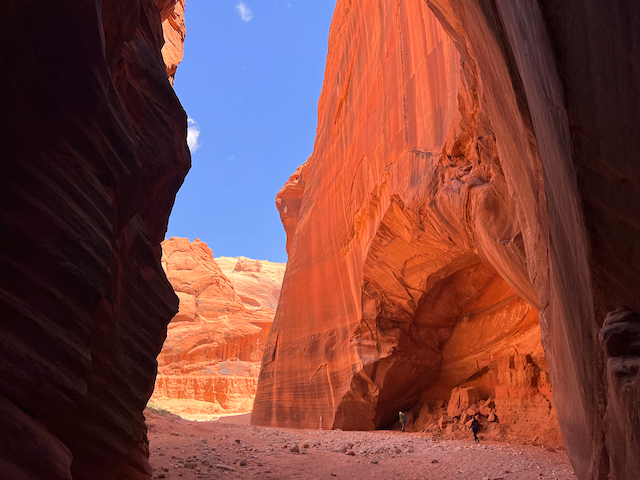
After eating out every night so far on this little camping trip we finally made dinner at the camper. Jerry found enough left over firewood to make a little fire and we cooked our curried pork satays over an open flame.
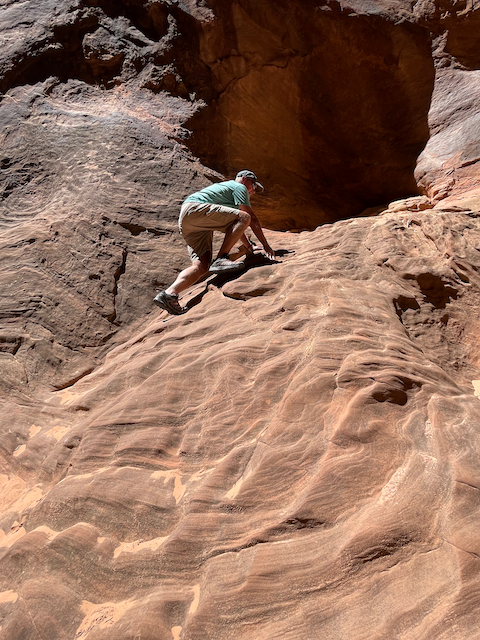
Cruising Lake Powell
Houseboat by sheer cliffs
private beach with no neighbors
billions of bright stars
After piloting a 50 foot houseboat for an afternoon, I think I’m ready to give cruise ships a try! It’s probably not that much different…
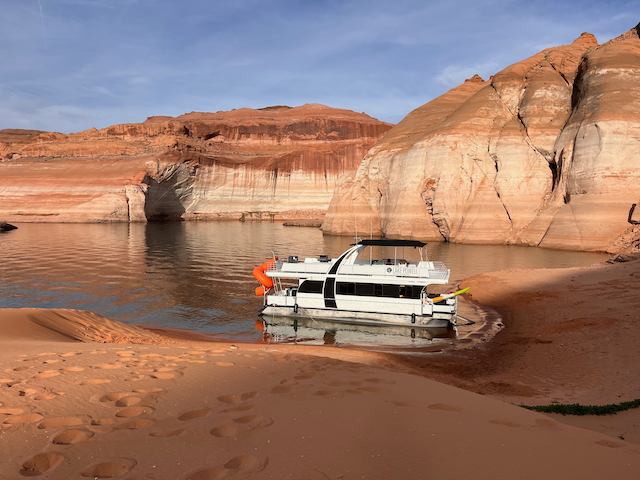
We arrived at the rental office and looked down, down, down the hill past where the water levels have been for decades down to the lowest point since the 1960’s. At the various marinas the self serve boat landings end 50 feet above the water level! That is gonna be a long way to schlep all this stuff was the common sentiment among our group.
Luckily the checkin process went much better than we were expecting, and after our orientation on the boat our person had a gator with two wagons attached to ride up the hill and fetch all of our stuff! The houseboat itself is a wonder, and much nicer than we were anticipating! There are lots of little details to remember about running the generator to charge the batteries, what things run on AC power and what things run on batteries with the inverter. For the most part you don’t really have to worry too much. We have just started the generator at the times we want to cook and while we are cooking the batteries get recharged. Plus there is a nice gas grill on the top deck for cooking as well.
Once we had everything stowed we were ready to get under way. They give you surprisingly little training for driving a giant boat, but one of the guides kindly accompanied us out of the harbor, watch over my shoulder and sharing a few tips for steering. The bottom line is that you don’t turn a houseboat on a dime, you need to anticipate and not oversteer.
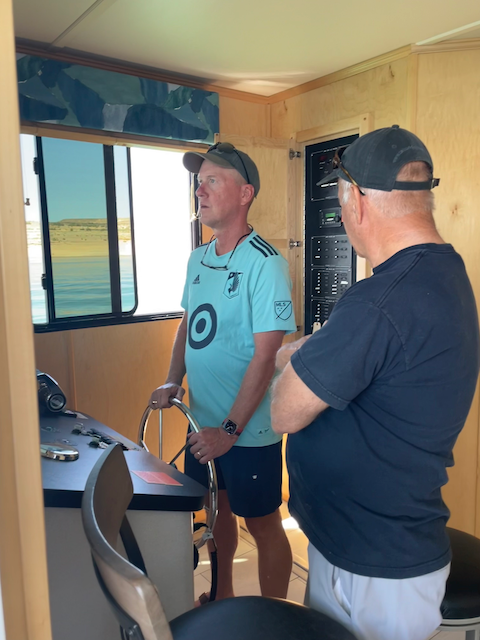
Next stop was the Wahweap Marina, below the lodge, for some reason the kayak rental place we used cannot deliver to the boat rental place. So I already had to figure out how to go and dock this big thing. The pilot helping me out seemed very skeptical about the whole idea. “Maybe they can just bring the kayaks to you in a boat?” Despite his lack of faith I did find a place to dock and we got the Kayaks loaded and headed on our way. The general consensus was that Navajo Canyon was our best bet for finding a place to beach the houseboat. So off we went!
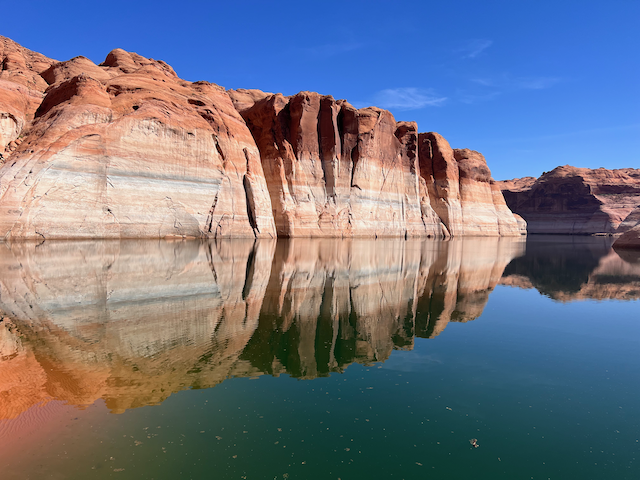
Part of the way back into Navajo canyon we found a magnificent spot! It was clearly a spot recently used as the holes for the anchors were already dug in all the right spots for us. So yay! That saved us a bunch of work. We may stay here until we have to leave on Sunday. We are truly disconnected here, no cell service at all, no WiFi or anything. Hopefully all is well in the world!
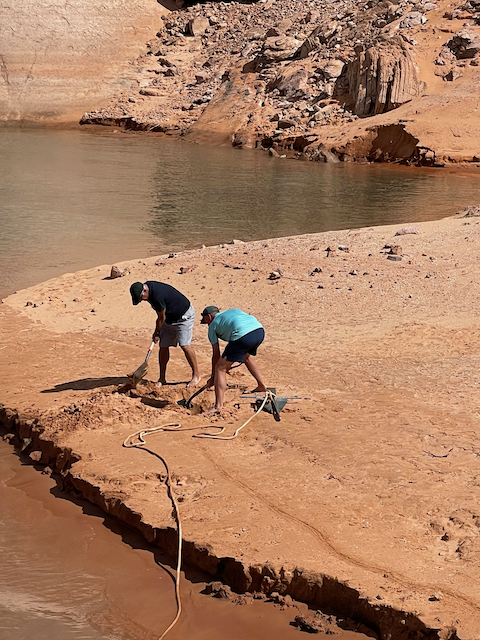
Ann and Jane did a little exploring in some nearby coves!
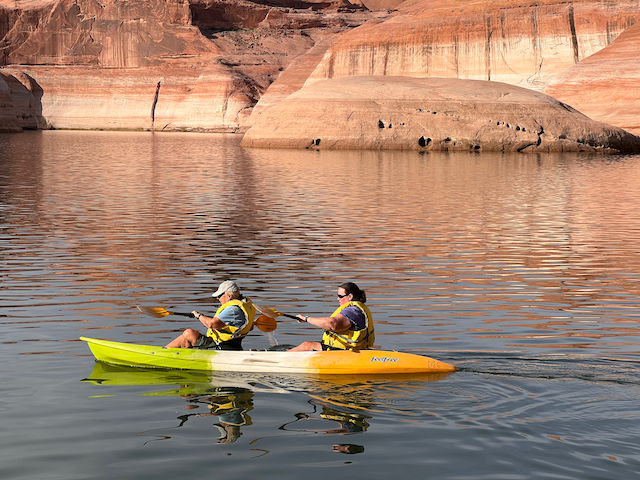
After a dinner of Peruvian Chicken we taught Ann and Jerry to play a new game. Before retiring for the night we all went on the top deck and lay face up on the mats — STARS — a clear sky and no light pollution makes for a spectacular view.
Driving to Page
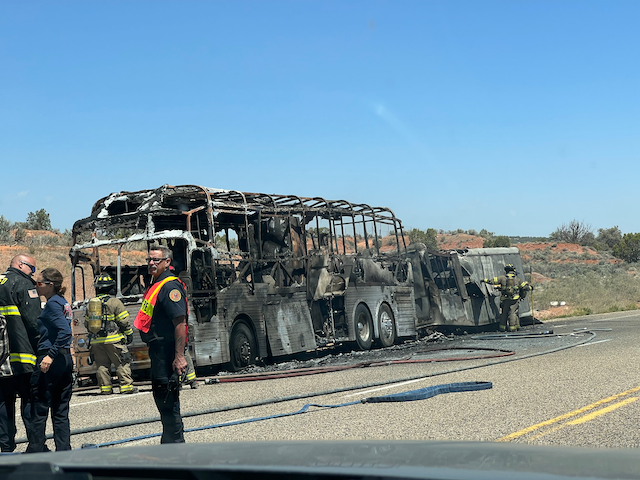
Today was mostly just getting from Zion over to Page Arizona. We had to take the camper through the tunnel, which was interesting because they make the tunnel one way traffic whenever there is a camper or bus that needs to go through. The road is just a little too narrow for comfort and although two campers could probably pass each other many mirrors would be broken. From there we went through Kanab and then onward toward Page Arizona.
About 20 miles outside of Kanab we came to a sudden stop. There was a huge lineup of cars on our side of the road and no oncoming traffic except for the few cars we could see turning around. With no cell service it was a total mystery as to what had transpired ahead. We assumed it was an accident of some kind. But how long would we have to wait? After sitting some time the paramedics from Kanab came by heading toward the accident, so we knew it would be quite a while. Jerry and I decided to take a little hike up the road to see if we could find any information or even just to see if we could see the start of the backup. After walking about a mile we started chatting with another person who said that there had been a lot of smoke and the word was that a camper had tipped over and caught fire. Rescue crews were looking for volunteer vehicles to help clear the road. But nobody knew how long it would be before we could get underway.
We met people with timed reservations at Antelope canyon, and others on their way to Lake Powell every car on our walk back wanted to know if we had learned anything. We we tried to tell what we knew in ever decreasing detail. A few minutes after getting back to the car we could see the front of the line start to move. It was just about 1 hour delay. Luckily we were not on any time schedule. We could clearly see the problem when we got to the front! We hope everyone survived! This really made us think about the dangers of driving in remote areas, no cell service in this area? We can only imagine how long that RV burned before word got to the authorities and someone was able to respond 20 miles from the nearest town!
The other unfortunate thing about the day was that the wind was just howling 20 mph with gusts of much more. At our campsite we could hardly close our door with both hands! Needless to say we were not going to sit around in the camper in the wind, so we headed down to see horseshoe bend. It takes a bit to walk down to the viewpoint and on the way there we had convinced ourselves that the wind was letting up a bit. But when we got to the edge of the canyon overlooking the bend we were sand blasted! You could hardly stand it with the bits of sand and gravel whipping around and stinging your skin.
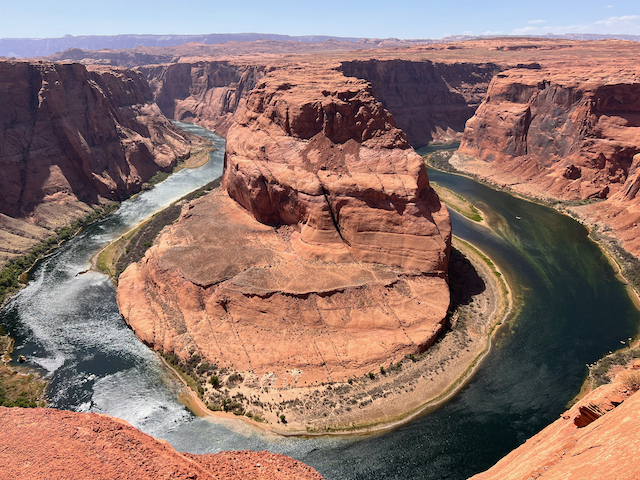
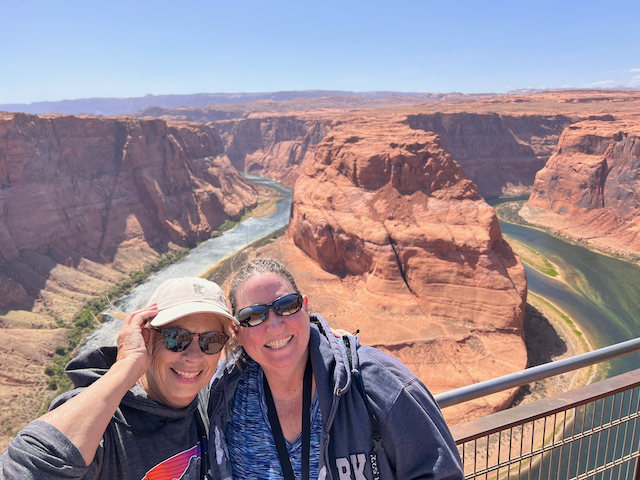
So maybe outdoor hiking is not a good idea today either. Maybe we should go into page to the brewery and distillery? That turned out to be a great call. Good beer, decent pizza and some really nice gin — made with botanicals. Yes, I am on vacation I had gin and beer.
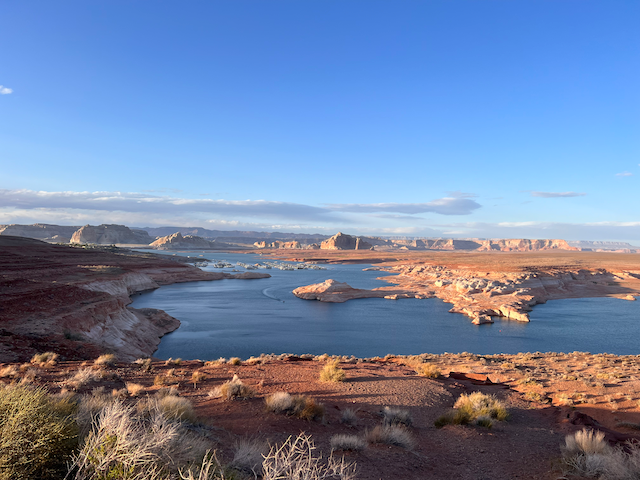

Back at the camper the wind had calmed down so we settled in for a rousing game of “Mexican Train” dominoes. It was a game full of twists and turns, just when we thought we had it figured out Jane staged a dramatic last minute victory.
Zion Narrows - I Know how to Save a Life
Suddenly floating
Down the river goes my wife
Someone grab her hat!
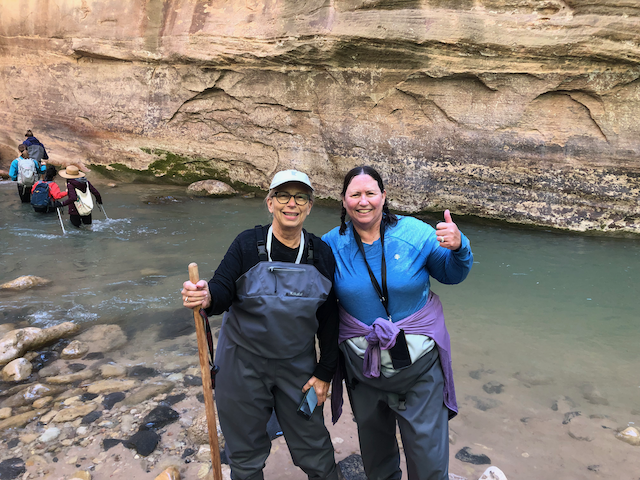
It was a beautiful morning in Zion National Park, we were up early to get to the outfitters to rent our waders/dry suits for the hike in the Zion Narrows. This is a hike we have wanted to do since 2009 when we brought the kids with us to Zion. It was worth the wait and is definitely in my top 10 list of hikes.
The water temperature was 56 degrees and the river was flowing at 46 cubic feet per minute. So it was not too high, but it was rapid enough that a lot of the time we really needed our poles to stabilize ourselves. I was under the impression that the entire hike was in the river. Thank God it was not. A lot of the hike involves zig zagging back and forth to get to dry land to walk on a trail for a short distance before going to the other side to do the same.
I felt like an explorer as you could not see very far ahead, so at every turn there was another turn just up ahead and you never knew what was coming up next.
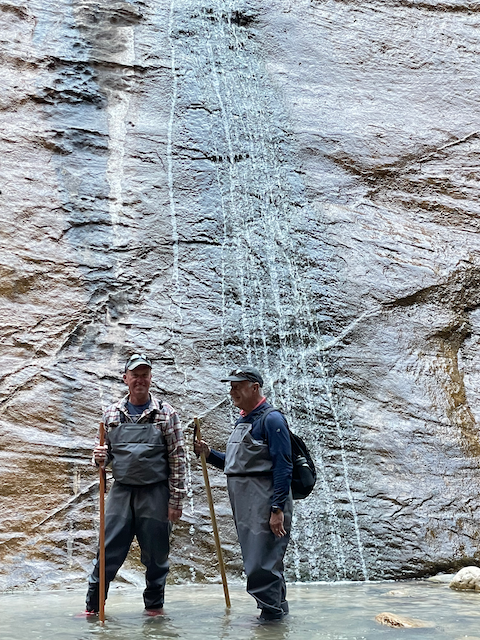
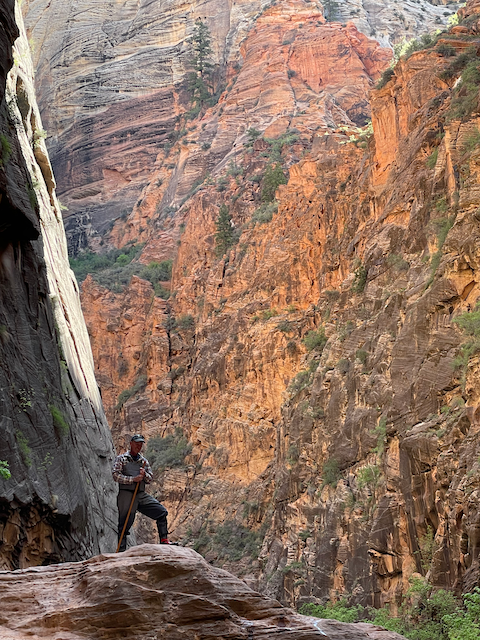
Our goal was to make it to the split and then walk a little further upstream to “Wall Street” where things get even more narrow. Which we did, we also explored a path to a waterfall. But that was not too productive, as there was a mini waterfall and boulder in our way. So we headed back.
When we arrived at the deepest crossing that also had a very strong current that was when things went awry. I was walking just ahead of Jane when I saw her start to float by! She had stumbled and done a slow fall into the deeper water. I was able to grab on to her and get her upright but not before a bunch of very cold water had gone over the top of her dry suit bibs! Her hat started to float downstream but luckily some nice young person was there to stop it. When we got out of the water on the other bank we looked back to find that Ann had stumbled in the water as well.
The dry suit did an excellent job of keeping out the water for most of the trip, and now it was doing an equally good job of keeping the water in! Which meant that every time jane got into a little deeper water the pressure on the suit forced the cold water inside the suit to squeeze up! Not comfortable. At this point our hike became a march to get back to the trailhead as quickly as we could to get the women out of their wet clothes. Unfortunately Ann fell one more time in the water and then took a tumble on some rocks on the land and bruised her elbow and banged up her knee.
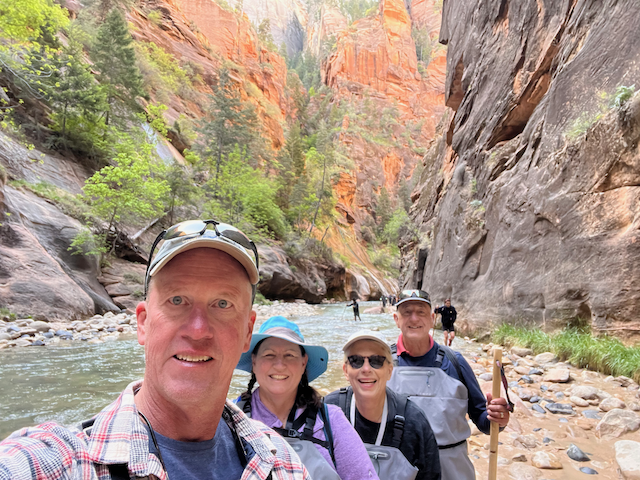
Despite it all we still enjoyed some awesome scenery along the way. When we arrived at the trailhead it was quite a process to remove all of our wet gear. I pulled open the cuff on Jane’s dry suit and a gallon of water came pouring out. We still had a one mile hike to get back to the busses which was just about enough time for their wet clothes to dry out.
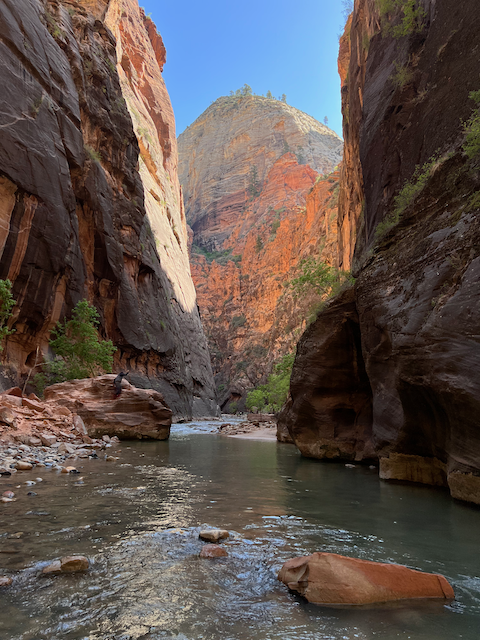
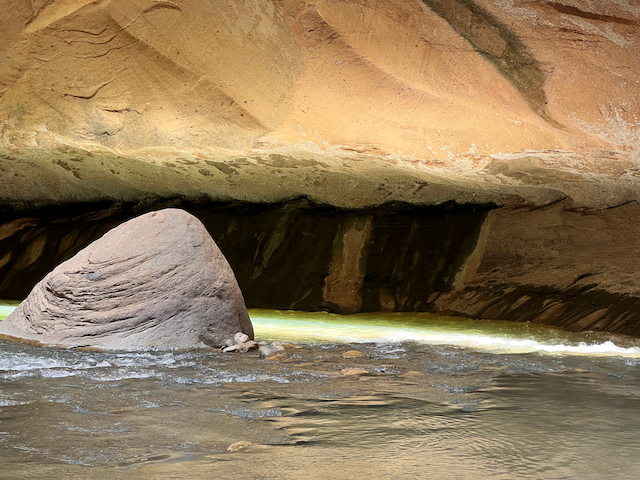
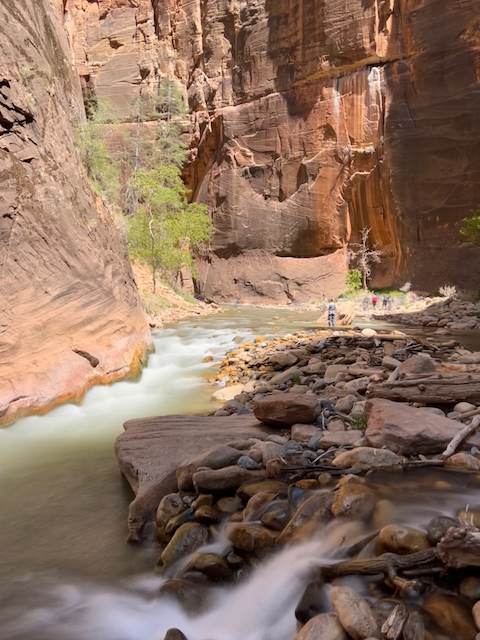
We were all amazed and surprised at the casual nature of the outfitters in town. Here is some stuff, try it on and let me know if you need a different size. Signing the waiver of liability was totally on the honor system, and paying seemed to be an honor system thing as well. How they knew what we had taken or paid for, or even returned is a mystery. I guess a dry suit is not something you are likely to steal, but it felt nice and refreshing to not have to sign and number and carefully check in and out each piece of gear!
This is a hike we would definitely repeat with our family if we ever get back here again.
We arrived safely back at our campsite where we packed up some drinks and our swimsuits and headed to the east side of the park. We needed to get inside the geofence area to get in the daily lottery for a chance to hike the Wave. They only allow 64 people a day into the Wave so it takes some luck. After driving even further than we wanted to we finally got enough cell signal to enter. It was kind of funny with four of us and four different generations of iPhones each with different signal strength trying to get the recreation.gov app to work with only a single bar of LTE signal!
After finally succeeding in getting two of us in the lottery we gave up and headed over to Ann and Jerry’s hotel to use the hot tub! That felt great. Jerry offered to buy us all dinner if we could go to a sports bar where he could attempt to turn us into Phoenix Suns fans.
Seminole Canyon State Park
After some city time we were excited to get back to nature. Its hard to believe that we only have six days left before we arrive in Indio. Living in the camper has somehow become our “new normal”.
We are back in desert country so our campsite didn’t have many trees, but it did have a great view of the sky and the horizon. We did a pretty long hike along the canyon rim where we were able to see the Rio Grande river and look across into Mexico. The hike was just over seven and a half miles so our feet were tired by the time we got back from this hot dusty walk.
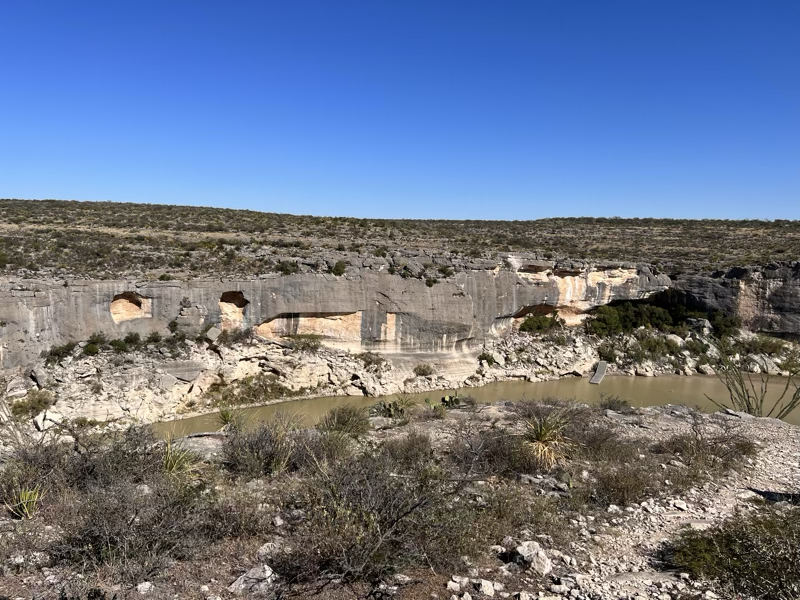
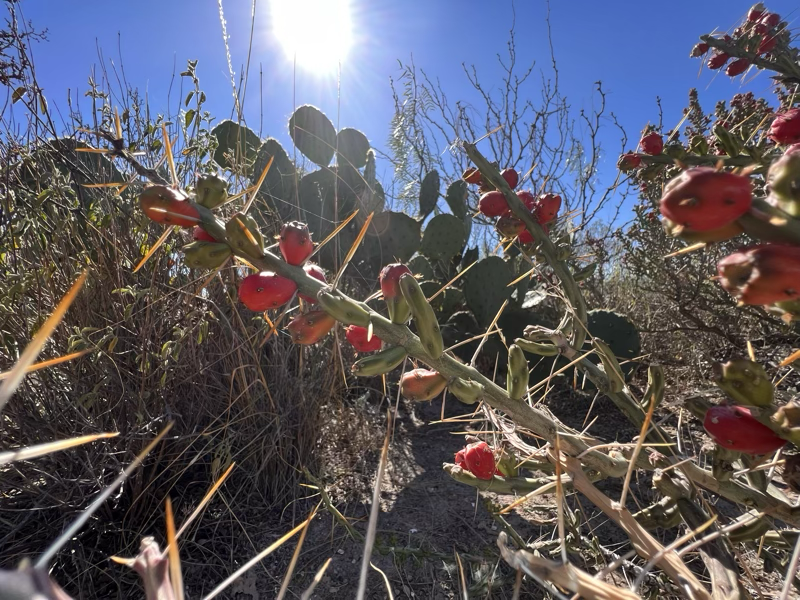
Since this was our last opportunity to have a campfire and cook over an open flame we made the most of it and enjoyed some time under the stars. I played around with my new phone features and got a couple of nice nighttime shots.
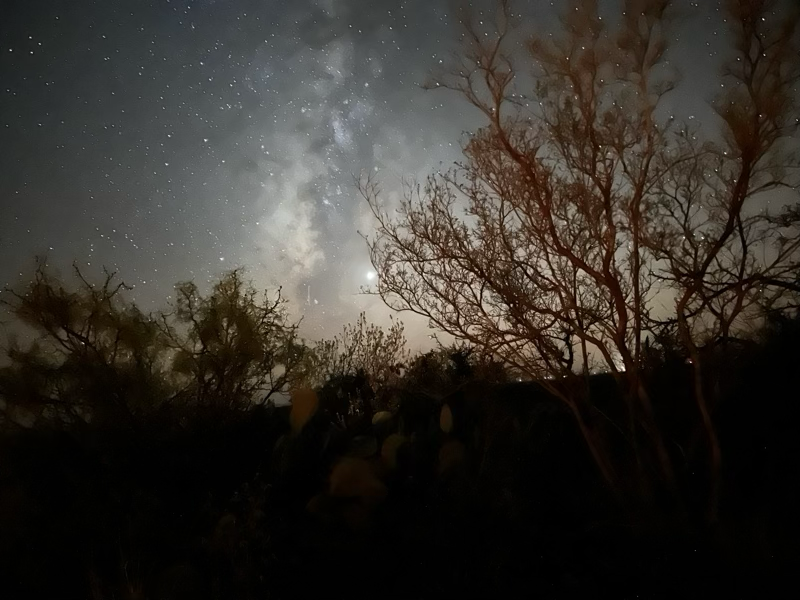

In the morning you can see that we had a beautiful sunrise!
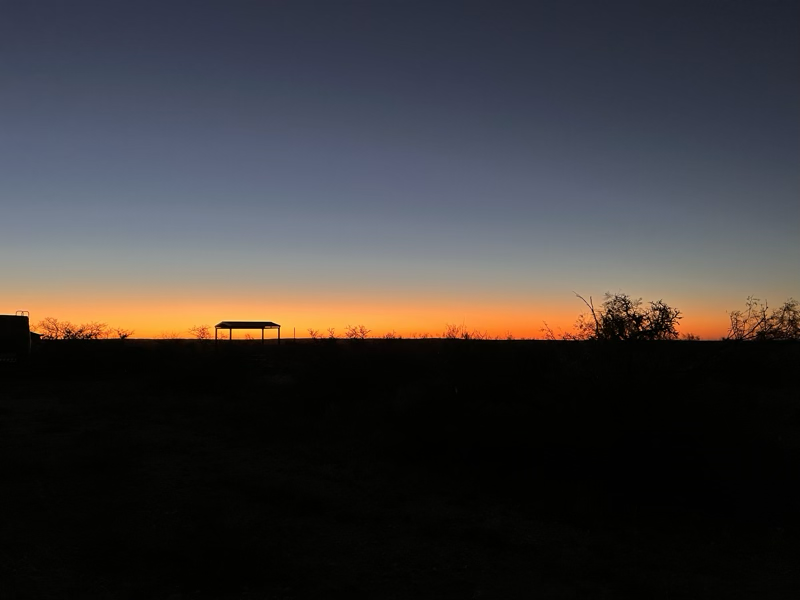
Winter Wonderland at White Sands
I was looking down at my phone or something inside the car when we made the transition. I looked up and saw this sight!
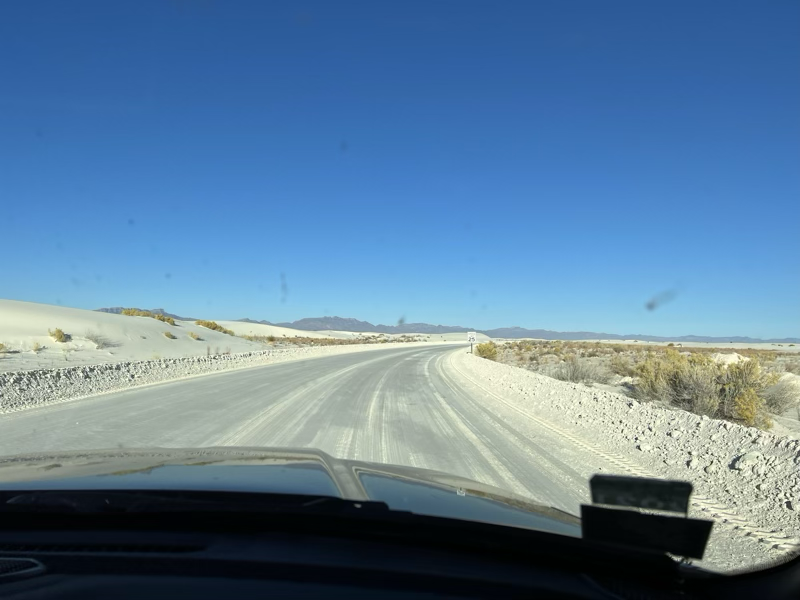
It looked like we had suddenly been transported to Wisconsin in the middle of January! Instead we were at White Sands National Monument in New Mexico. Not far from the Missile Range and the test site for the Manhattan Project.
We did some messing around on the dunes, enjoying the beautiful contrast between the white sand and the clear blue sky!
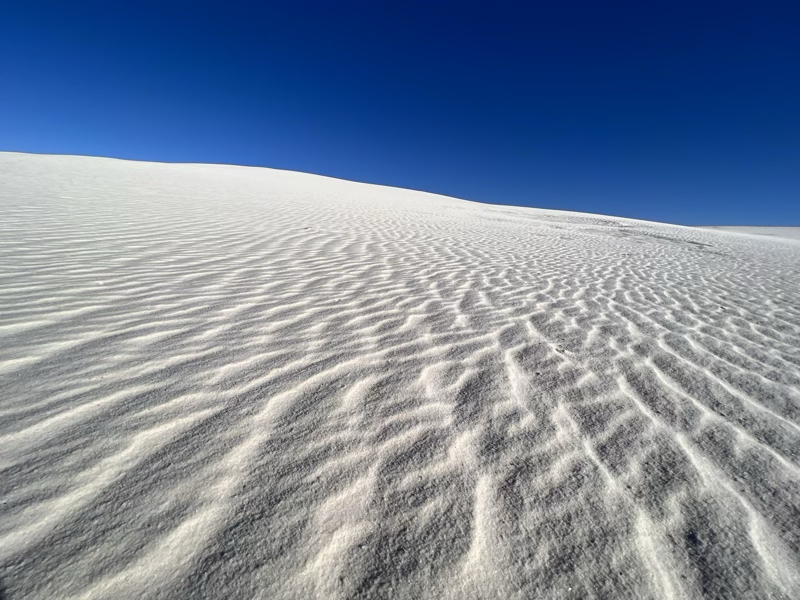
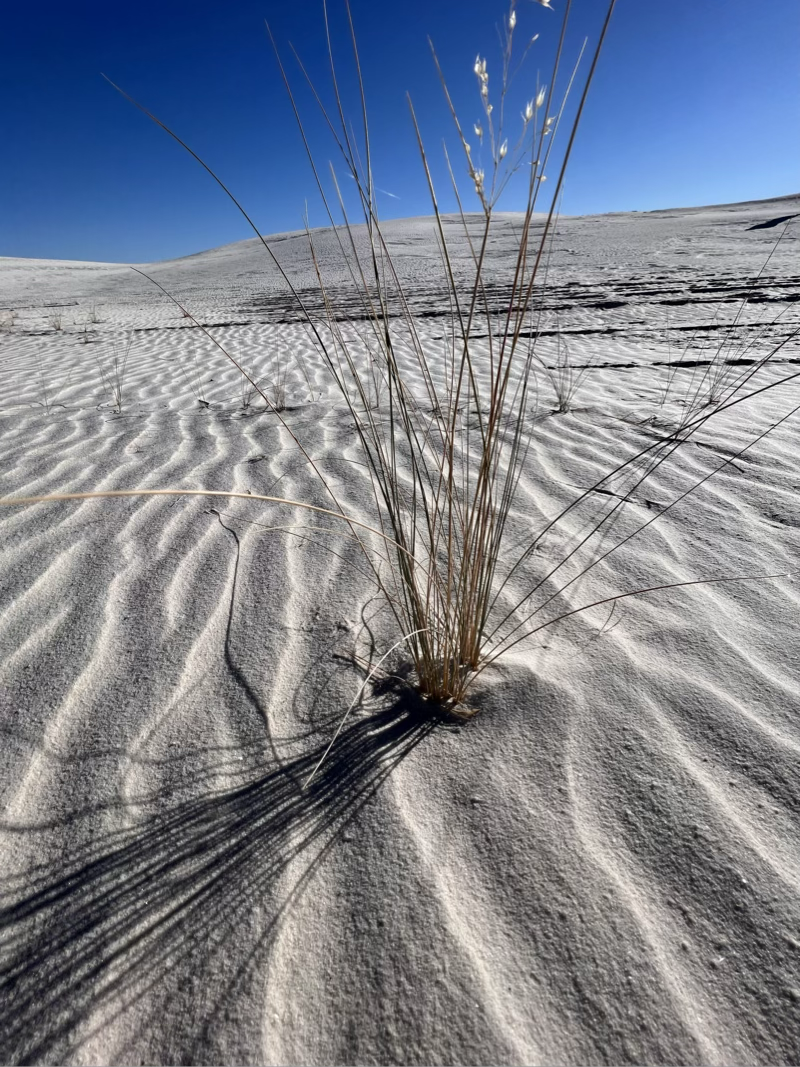
From White Sands we went back to our campsite at Leasburg Dam and hooked up to head further west. We had opted for a KOA in Wilcox AZ for the night so we could have all our tanks clean and empty for the final drive to Indio.
Little did we know that Wilcox is some kind of wine Mecca for the state of Arizona. Who ever heard of an Arizona wine anyway? We had to give them a try so after making camp and doing a little work with the good WiFi. We headed to the Coronado Winery to test a few wines and enjoy some of their food. The wine was actually really good, I ended up buying a bottle of their Rose to take with me and Jane bought a bottle of the Sangiovese.
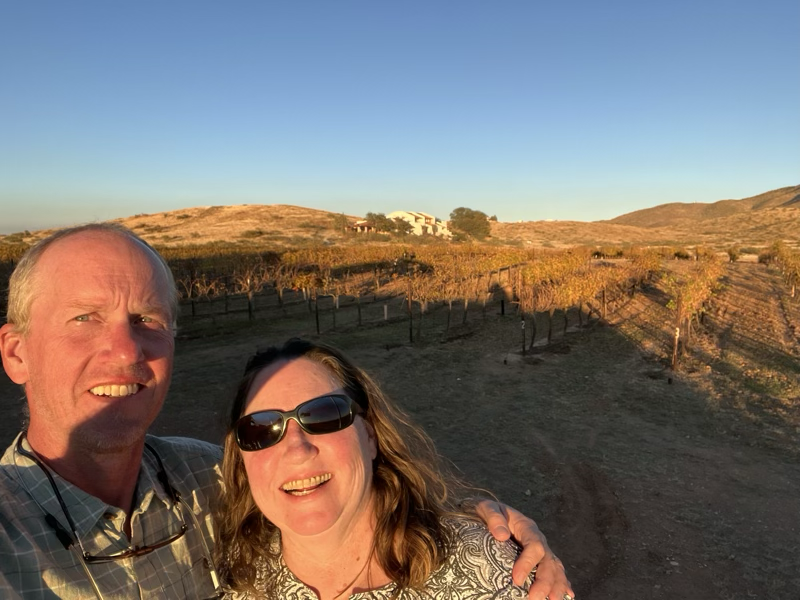
Its been an incredible trip and all we have left is about six hours of driving on I-10 tomorrow! Depending on how early we get on the road we will be in Indio by early to mid-afternoon. Lots to look forward to there, and looking forward to reconnecting with all of our Indio friends, golfing partners and pickleball players!
Big Bend National Park
After a beautiful night at Seminole Canyon, we were on our way to Big Bend National Park. This is a good time to see this park as Big Bend is definitely not on the way to anywhere. The park is huge, and very remote. It borders the Rio Grande and has some spectacular hiking.
Getting into our “pull through” site was our first adventure. It was on the wrong side of the road for our camper so first we had to drive down the road the wrong way. The site is on a hill and half of the site is very sloped so we had to pull up to the level area and leave the pickup blocking the road until we were leveled and unhooked. Thankfully the rangers around here are very friendly and understanding. One even told us that he would block traffic for us when we left if he was around to make it easy for us to go the wrong way. I love a friendly rule breaker!
After some sandwiches for lunch I worked a bit and read with the idea that we would do the hike to the Window sometime after 4:00. This turned out to be a great decision as we ended up in shade for most of the hike and on the way back we had just beautiful light on the mountains. This hike was downhill from the start and uphill all the way back!
This was the end of the hike where we could see the plains below the window from our valley!
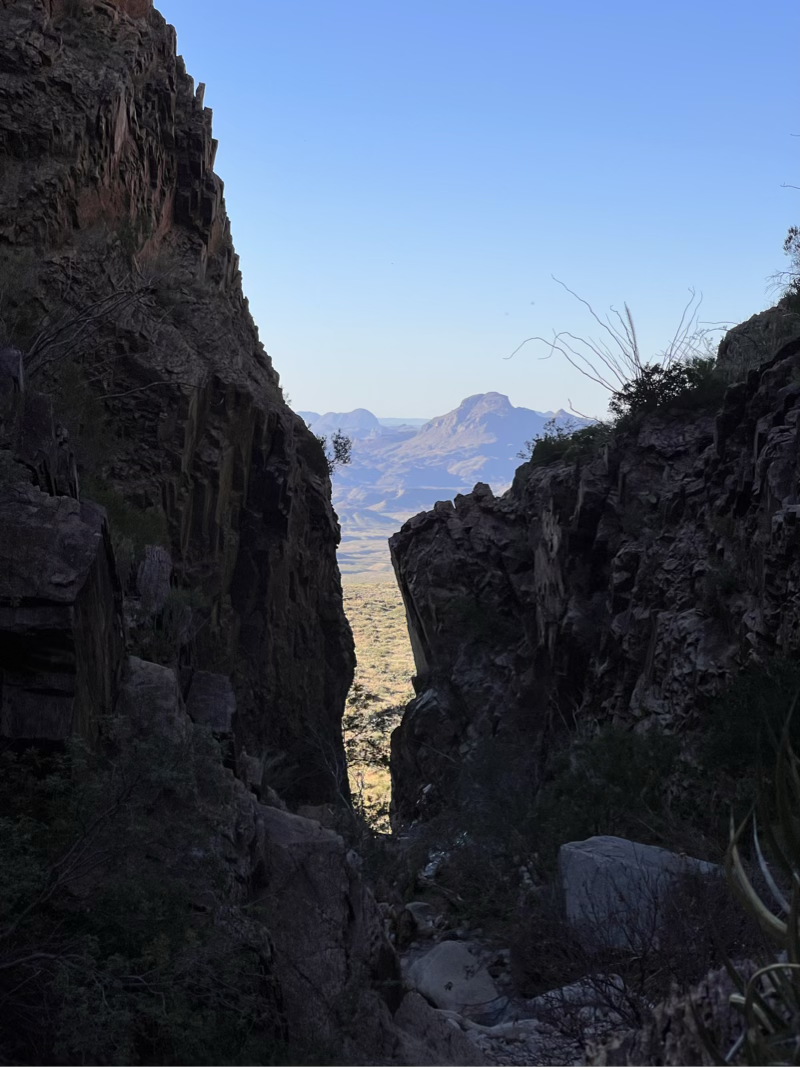
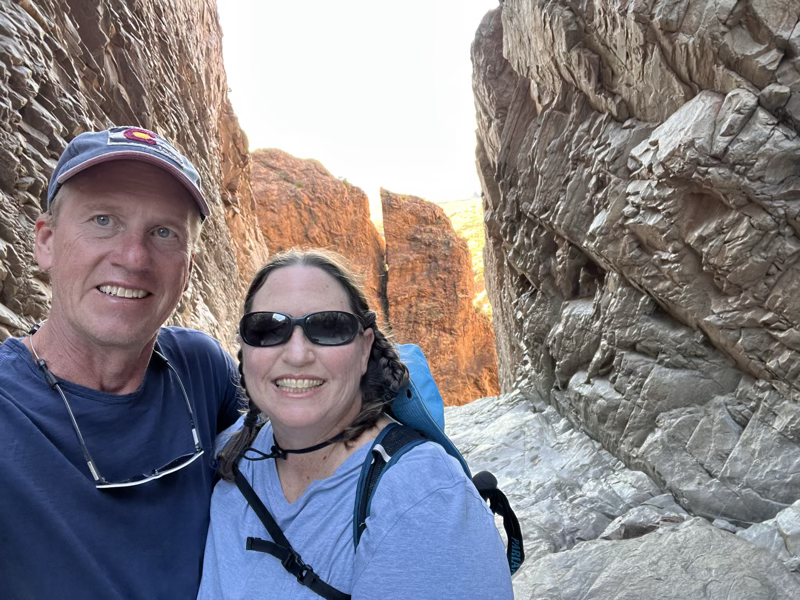
On the way back we had several opportunities to enjoy the beautiful lighting! This one is my favorite, I really love the reflection of the mountains beyond in this tiny pool.
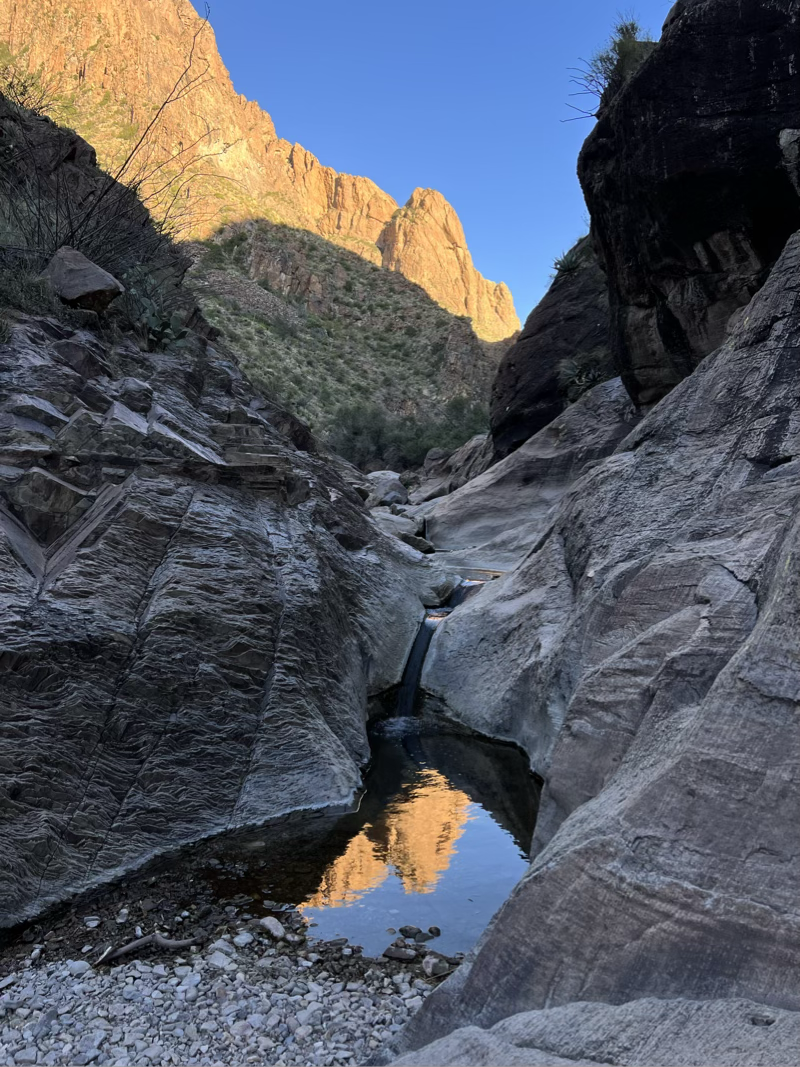
I also loved the contrast in the lighting, from the shadow we were walking in to the canyon walls still in bright, late afternoon sunlight!
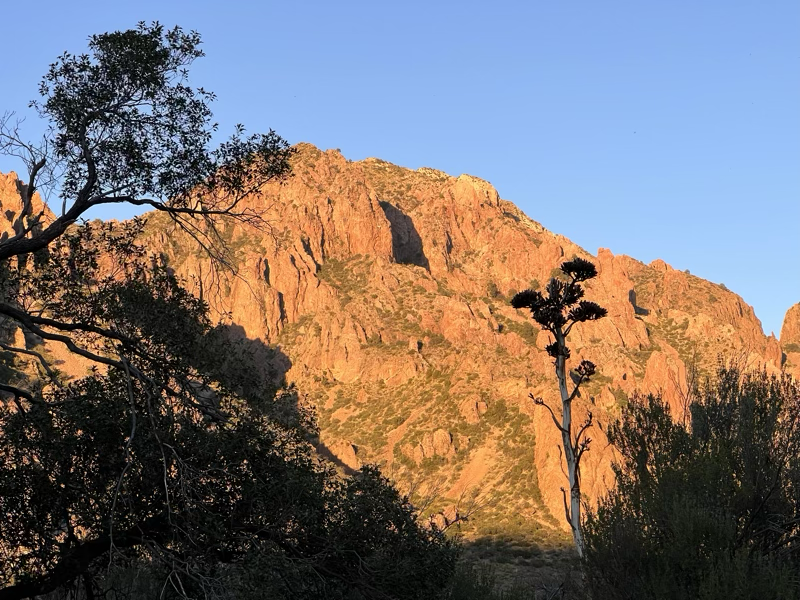
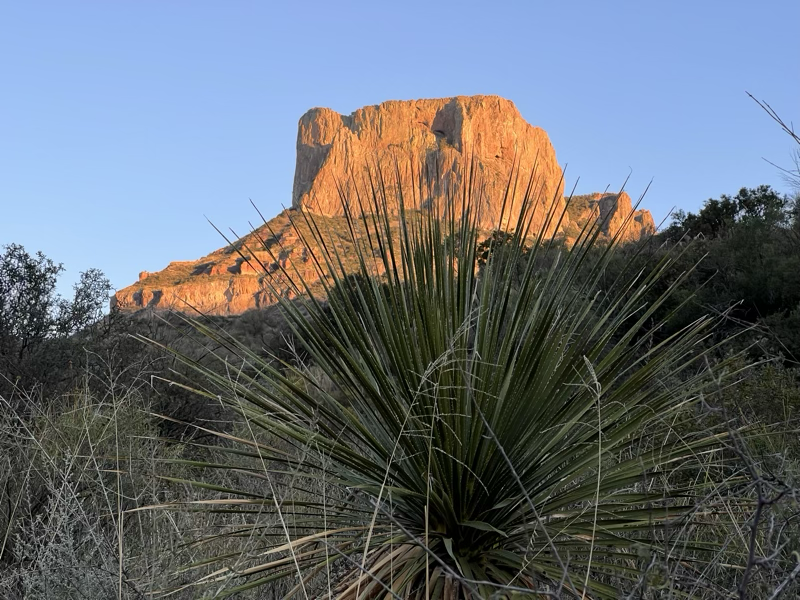
We didn’t get back from the hike until after 7:00 so after a drink and a bit of rest it was dark by the time I started the griddle for supper. We had decided on fried burgers. I haven’t made a burger on a flat top in forever, but let me tell you, it was great! Nicely browned on the outside and we toasted some buttered buns right next to the burgers! It took me right back to my childhood having burgers at the Cafe in Storden Minnesota with my grandma Sundahl.
This morning we were up and waiting for the sun to clear the canyon wall so we could position the solar panels for the day before we took off on our sightseeing tour. It was great.
We followed the Ross Maxwell road (an early park super) and it was beautiful! The highlight of the trip was the view of “the notch” No! not the one on the iPhone or the new macbook pro, but a gigantic notch between the mountains carved out by the Rio Grande! This was our first view of it from about 10 miles away!
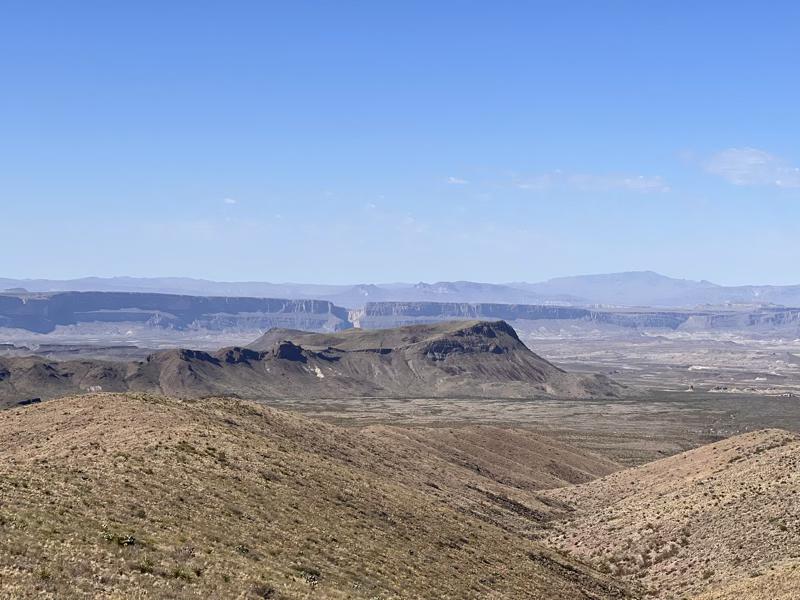
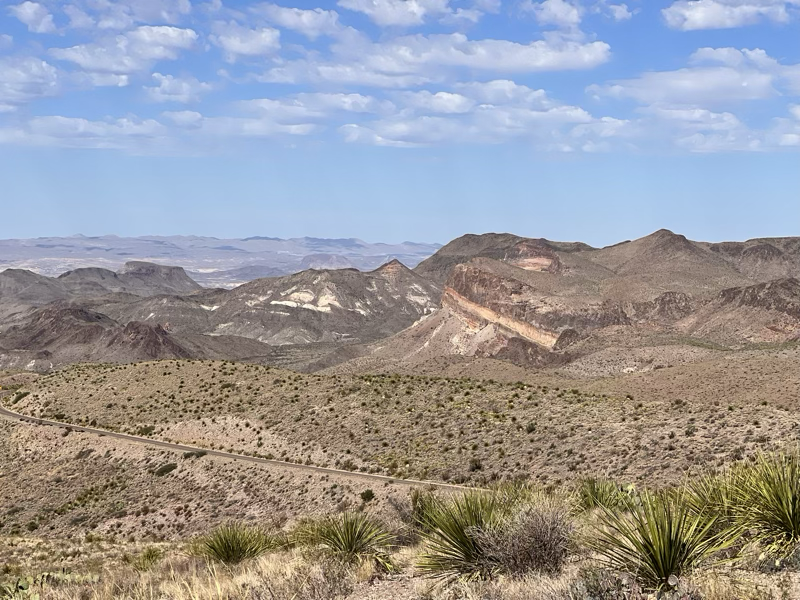
When we got closer it was great to get out and walk into the canyon. The drought is so bad that the Rio Grande is very low .
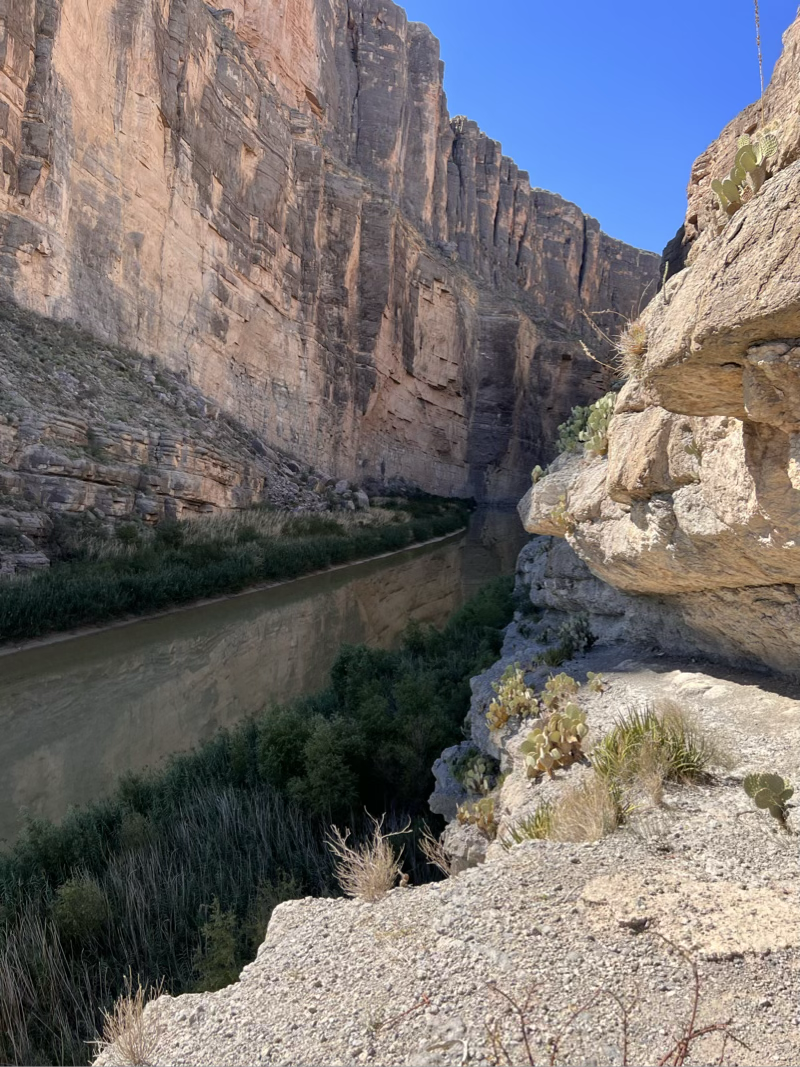
So low, in fact, that we were definitely in Mexico for a few minutes!
